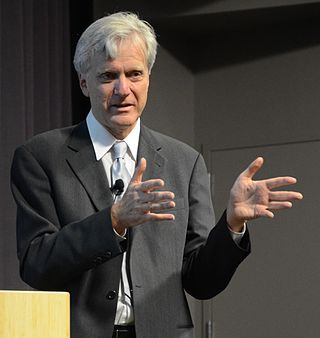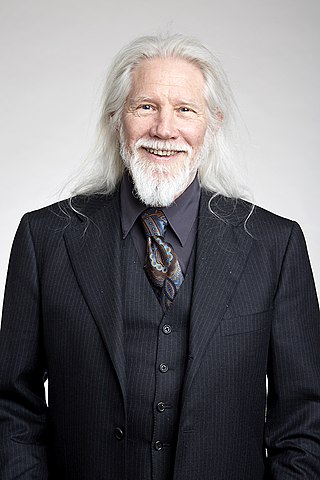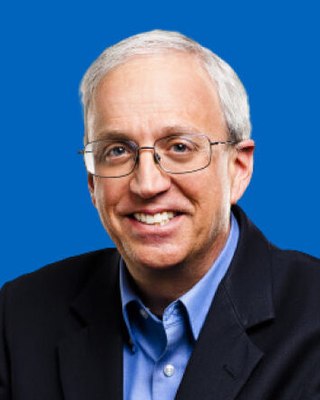Robert Drost | |
|---|---|
| Born | August 17, 1970 New York City, United States |
| Alma mater | Stanford University |
| Occupation | Computer Architect |
Robert Drost is an American computer scientist. He was born in 1970 in New York City.
Robert Drost | |
|---|---|
| Born | August 17, 1970 New York City, United States |
| Alma mater | Stanford University |
| Occupation | Computer Architect |
Robert Drost is an American computer scientist. He was born in 1970 in New York City.
Drost joined Sun Microsystems in 1993 after obtaining a B.S. and M.S. in Electrical Engineering from Stanford University. In 2001 he earned a Ph.D. in Electrical Engineering and a Ph.D. minor in Computer Science from Stanford.[ citation needed ] As of 2011 he is a holder of over 95 patents [1] in microelectronics.
Until 2010, Drost was Distinguished Engineer and Senior Director of Advanced Hardware at Sun Microsystems, helping to pioneer wireless connections between computer chips [2] called proximity communication. [3]
Since 2010, Drost has had various roles, including CEO, COO, and CFO, at Pluribus Networks, Inc., a Palo Alto–based startup that he co-founded with Sunay Tripathi and Chih-Kong Ken Yang.[ citation needed ]

Ivan Edward Sutherland is an American computer scientist and Internet pioneer, widely regarded as a pioneer of computer graphics. His early work in computer graphics as well as his teaching with David C. Evans in that subject at the University of Utah in the 1970s was pioneering in the field. Sutherland, Evans, and their students from that era developed several foundations of modern computer graphics. He received the Turing Award from the Association for Computing Machinery in 1988 for the invention of the Sketchpad, an early predecessor to the sort of graphical user interface that has become ubiquitous in personal computers. He is a member of the National Academy of Engineering, as well as the National Academy of Sciences among many other major awards. In 2012, he was awarded the Kyoto Prize in Advanced Technology for "pioneering achievements in the development of computer graphics and interactive interfaces".

Andreas Maria Maximilian Freiherr von Mauchenheim genannt Bechtolsheim is a German electrical engineer, entrepreneur and investor. He co-founded Sun Microsystems in 1982 and was its chief hardware designer. As of March 2024, Forbes estimated his net worth at $16.3 billion.

William Daniel Hillis is an American inventor, entrepreneur, and computer scientist, who pioneered parallel computers and their use in artificial intelligence. He founded Thinking Machines Corporation, a parallel supercomputer manufacturer, and subsequently was Vice President of Research and Disney Fellow at Walt Disney Imagineering.

Bailey Whitfield 'Whit' Diffie ForMemRS is an American cryptographer and mathematician and one of the pioneers of public-key cryptography along with Martin Hellman and Ralph Merkle. Diffie and Hellman's 1976 paper New Directions in Cryptography introduced a radically new method of distributing cryptographic keys, that helped solve key distribution—a fundamental problem in cryptography. Their technique became known as Diffie–Hellman key exchange. The article stimulated the almost immediate public development of a new class of encryption algorithms, the asymmetric key algorithms.

Radia Joy Perlman is an American computer programmer and network engineer. She is a major figure in assembling the networks and technology to enable what we now know as the internet. She is most famous for her invention of the Spanning Tree Protocol (STP), which is fundamental to the operation of network bridges, while working for Digital Equipment Corporation, thus earning her nickname "Mother of the Internet". Her innovations have made a huge impact on how networks self-organize and move data. She also made large contributions to many other areas of network design and standardization: for example, enabling today's link-state routing protocols, to be more robust, scalable, and easy to manage.

Norman Manuel Abramson was an American engineer and computer scientist, most known for developing the ALOHAnet system for wireless computer communication.

William James Dally is an American computer scientist and educator. He is the chief scientist and senior vice president at Nvidia and was previously a professor of Electrical Engineering and Computer Science at Stanford University and MIT. Since 2021, he has been a member of the President's Council of Advisors on Science and Technology (PCAST).

Mark A. Horowitz is an American electrical engineer, computer scientist, inventor, and entrepreneur who is the Yahoo! Founders Professor in the School of Engineering and the Fortinet Founders Chair of the Department of Electrical Engineering at Stanford University. He holds a joint appointment in the Electrical Engineering and Computer Science departments and previously served as the Chair of the Electrical Engineering department from 2008 to 2012. He is a co-founder, the former chairman, and the former chief scientist of Rambus Inc.. Horowitz has authored over 700 published conference and research papers and is among the most highly-cited computer architects of all time. He is a prolific inventor and holds 374 patents as of 2023.
Proximity communication is a Sun microsystems technology of wireless chip-to-chip communications. Partly by Robert Drost and Ivan Sutherland. Research done as part of High Productivity Computing Systems DARPA project.

Danny Cohen was an Israeli American computer scientist specializing in computer networking. He was involved in the ARPAnet project and helped develop various fundamental applications for the Internet. He was one of the key figures behind the separation of TCP and IP ; this allowed the later creation of UDP.
Richard J. Mammone is an American engineer, inventor, entrepreneur and professor. As an inventor, he holds over 15 patents. To date, he has formed four technology companies including SpeakEZ, a firm that specialized in voice recognition technology, and Computed Anatomy Inc., the business that pioneered LASIK eye surgery.

John Mathew Cioffi is an American electrical engineer, educator and inventor who has made contributions in telecommunication system theory, specifically in coding theory and information theory. Best known as "the father of DSL," Cioffi's pioneering research was instrumental in making digital subscriber line (DSL) technology practical and has led to over 400 publications and more than 100 pending or issued patents, many of which are licensed.

Oyekunle Ayinde "Kunle" Olukotun is a British-born Nigerian computer scientist who is the Cadence Design Systems Professor of the Stanford School of Engineering, Professor of Electrical Engineering and Computer Science at Stanford University and the director of the Stanford Pervasive Parallelism Lab. Olukotun is known as the “father of the multi-core processor”, and the leader of the Stanford Hydra Chip Multiprocessor research project. Olukotun's achievements include designing the first general-purpose multi-core CPU, innovating single-chip multiprocessor and multi-threaded processor design, and pioneering multicore CPUs and GPUs, transactional memory technology and domain-specific languages programming models. Olukotun's research interests include computer architecture, parallel programming environments and scalable parallel systems, domain specific languages and high-level compilers.
Geoffrey Louis Barrows is an American inventor and the founder of Centeye, a company that specializes in the development of insect vision for robotics. In 2003 he was recognized as a Young Innovator by being included in the MIT Technology Review's TR100 list. Barrows owns more than six patents for his technology.
Kwabena Adu Boahen is a Ghanaian-born Professor of Bioengineering and Electrical Engineering at Stanford University. He previously taught at the University of Pennsylvania.
Hossein Rahnama is a Canadian computer scientist, specialising in ubiquitous and pervasive computing. His research explores artificial intelligence, mobile human-computer interaction, and the effective design of contextual services. In 2017, Rahnama was included in Caldwell Partners' list of "Canada’s Top 40 Under 40". In 2012, he was recognized by the MIT Technology Review as one of the world’s top innovators under the age of 35 for his research in context-aware computing. The Smithsonian named Rahnama as one of the top six innovators to watch in 2013. Rahnama has 30 publications and 10 patents in ubiquitous computing, serves on the board of Canadian Science Publishing, and was a Council Member of the National Sciences and Engineering Research Council (NSERC). Rahnama is also a visiting scholar at the Human Dynamics group at MIT Media Lab in Cambridge, MA. He has a PhD in Computer Science from Ryerson University. Rahmnama is an associate professor in Toronto Metropolitan University's RTA School of Media and Director of Research & Innovation at the university's Digital Media Zone.

Dina Katabi, born 1970, is the Andrew and Erna Viterbi Professor of Electrical Engineering and Computer Science at MIT and the director of the MIT Wireless Center. She was designated as one of the world’s most influential women engineers by Forbes magazine.
Chih-Kong Ken Yang is a professor of electrical engineering at the University of California, Los Angeles (UCLA), Director of the Integrated Circuits and Systems Laboratories (ICSL), and co-founder of Pluribus Networks, Inc.
John X. J. Zhang is a tenured professor at Thayer School of Engineering of Dartmouth College, and an investigator in the Dartmouth-Hitchcock Medical Center. Before joining Dartmouth, he was an associate professor with tenure in the Department of Biomedical Engineering at the University of Texas(UT Austin). He received his Ph.D. in electrical engineering from Stanford University, California in 2004, and was a research scientist in systems biology at the Massachusetts Institute of Technology (MIT) before joining the faculty at UT Austin in 2005. Zhang is a Fellow of the American Institute for Medical and Biological Engineering (AIMBE), and a recipient of the 2016 NIH Director's Transformative Research Award.

Bernd Girod is a German-American engineer, the Robert L. and Audrey S. Hancock Professor of Electrical Engineering at Stanford University. Girod is a member of the National Academy of Engineering.